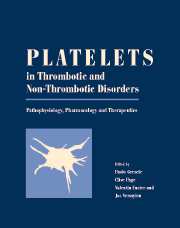Book contents
- Frontmatter
- Contents
- List of contributors
- Editors' preface
- PART I PHYSIOLOGY
- PART II METHODOLOGY
- PART III PATHOLOGY
- PART IV PHARMOLOGY
- 61 Aspirin
- 62 Pharmacology of ticlopidine and clopidogrel
- 63 Platelet membrane glycoprotein (GP) IIb–IIIa antagonists and acute arterial thrombosis
- 64 Other antiplatelet agents
- 65 Pharmacogenetics as a new antiplatelet strategy
- 66 Cardiovascular gene therapy: implications for platelet vessel wall interactions
- 67 Pharmacological modulation of the inflammatory actions of platelets
- PART V THERAPY
- Afterword: Platelets: a personal story
- Index
- Plate section
61 - Aspirin
from PART IV - PHARMOLOGY
Published online by Cambridge University Press: 10 May 2010
- Frontmatter
- Contents
- List of contributors
- Editors' preface
- PART I PHYSIOLOGY
- PART II METHODOLOGY
- PART III PATHOLOGY
- PART IV PHARMOLOGY
- 61 Aspirin
- 62 Pharmacology of ticlopidine and clopidogrel
- 63 Platelet membrane glycoprotein (GP) IIb–IIIa antagonists and acute arterial thrombosis
- 64 Other antiplatelet agents
- 65 Pharmacogenetics as a new antiplatelet strategy
- 66 Cardiovascular gene therapy: implications for platelet vessel wall interactions
- 67 Pharmacological modulation of the inflammatory actions of platelets
- PART V THERAPY
- Afterword: Platelets: a personal story
- Index
- Plate section
Summary
Acetylsalicylic acid was first marketed as aspirin in 1899 and used extensively over the next decades as a prototypic non-steroidal anti-inflammatory drug (NSAID). Following the seminal discoveries made by John Vane and Bengt Samuelsson in the early 1970s on the biochemistry and pharmacology of arachidonic acid metabolism, the molecular mechanism of action of aspirin in inhibiting platelet function was elucidated by the elegant studies of Philip Majerus. The development of whole blood thromboxane (TX)B2 production as a biochemical endpoint for human studies allowed the characterization of the doseand time-dependence of the antiplatelet effect of aspirin in the early 1980s. This, in turn, provided the rationale for a new wave of randomized clinical trials employing daily doses 10– to 50-fold lower than used empirically in the past. A large database consisting of over 100 clinical trials of aspirin prophylaxis in a wide range of vascular disorders now provides solid grounds for assessing the balance between benefits and risks in the whole spectrum of atherothrombosis.
Mechanism of action of aspirin
The best characterized mechanism of action of the drug is related to its capacity to inactivate permanently the cyclooxygenase (COX) activity of prostaglandin H-synthase (PGHS)-1 and -2 (also referred to as COX-1 and COX-2). These isozymes catalyse the first committed step in prostanoid biosynthesis, i.e., the conversion of arachidonic acid to PGH2. PGH2 is the immediate precursor of PGD2, PGE2, PGF2α, PGI2 and TXA2. COX-1 and COX-2 are homodimers of a ∼72 kDa monomeric unit.
- Type
- Chapter
- Information
- Platelets in Thrombotic and Non-Thrombotic DisordersPathophysiology, Pharmacology and Therapeutics, pp. 919 - 928Publisher: Cambridge University PressPrint publication year: 2002
- 2
- Cited by



